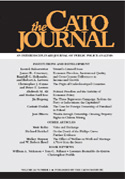Cato Journal: Why Project Labor Agreements Are Not in the Public Interest
A compelling article critical of government-mandated project labor agreements (PLAs) by David G. Tuerck, executive director of the Beacon Hill Institute for Public Policy Research, appears in the current issue of the Cato Journal (Volume 30 Number 1, Winter 2010, “Are Unions Good for America?”).

“Why Project Labor Agreements Are Not in the Public Interest” (pdf) surveys the historical decline of construction union membership and track-record of government-mandated PLAs. The article also documents the nexus between PLAs and federal and state prevailing wage laws, both of which are government-run special interest schemes used by Big Labor to artificially prop union wage premiums and market share.
For example, Tuerck explains that PLAs place nonunion contractors at a competitive disadvantage because of added “double benefit” costs in typical PLA agreements:
Thus, a PLA on a public project has the purpose and effect of reducing the competitive advantage of nonunion contractors, first by forcing them to pay twice for benefits already offered their workers and second by forcing pay cuts on their workers. It amounts to a straightforward effort by the construction unions to put nonunion firms and workers at a competitive disadvantage.
While making a strong case that PLAs are not in the public’s best interest, Tuerck summarizes arguments for and against PLAs that often fuel the debate surrounding this contentious issue. For example, Tuerck dismantles some of the methodology and false-logic often employed in studies promoting PLAs as a mechanism to reduce construction costs:
All such studies implicitly adopt a methodology in which they:
1. Take, as a given, the existence of costly work rules that benefit the unions (e.g., holiday pay concessions, favorable apprenticeship ratios, high overtime pay).
2. Identify work rules, among them costly rules given in (1), above, that would be modified under a PLA.
3. Show how much more it would have cost to perform the project had those rules not been modified.
4. Count (3) as a cost saving that argues for the PLA.This methodology presupposes that we can count as a cost “saving” some feature of a PLA that corrects for a problem that might otherwise go uncorrected once the project gets under way. But therein lays the error: Why, if correcting for a problem cuts cost, would it go uncorrected? An open bidding process forces firms competing for a project to cut costs to the end of submitting a winning bid. If the unions want their employers to succeed in bidding for a project, they have every incentive to remove problems that lead to higher costs.
It is not a cost saving to modify work rules that are inefficient to begin with and that would not survive a competitive bidding process.
If union contractors are underutilizing apprentices, then they are operating inefficiently and should not expect to win projects on which they bid. It makes no sense to score the modification of a work rule as a “cost saving” when a competitive bidder would have modified that work rule anyway.
On the other hand, it hardly matters in an open bidding process if the unions refuse to modify inefficient work rules or to cooperate in cutting costs. Some contractor, most probably a nonunion contractor (given the existing dominance of nonunion contractors over market share), will be perfectly willing to work out cost-saving adjustments in the work day or in the use of apprentices, without help from a PLA. Presumably, the contractor that is most successful in working out problems of this kind will submit the lowest bid. It makes no sense to say that failure to adopt a PLA precludes the adoption of cost-cutting measures, when those measures would have been adopted anyway without a PLA.
The purpose of the bidding process is to induce bidders to fashion work rules and assign tasks in such a way as to get the job done at the lowest cost. And the best way to achieve that purpose is to make sure that the bidding process is unencumbered by measures, such as a PLA, whose real purpose is to preserve work rules that benefit the unions at the expense of efficiency.
The unions want policymakers to believe that PLAs are effective for removing inefficient work rules before a project goes up for bid.
But the unions push for PLAs for the very reason that a PLA is the best way to make sure that some of the inefficient work rules from which they benefit will survive the bidding process.
Keep in mind Tuerck’s attack on the false logic used by PLA proponents next time you stand up against special interests when a PLA is being considered at the federal, state or local level – especially when a PLA is promoted as a tool to decrease construction costs in markets where nonunion contractors are strong.











